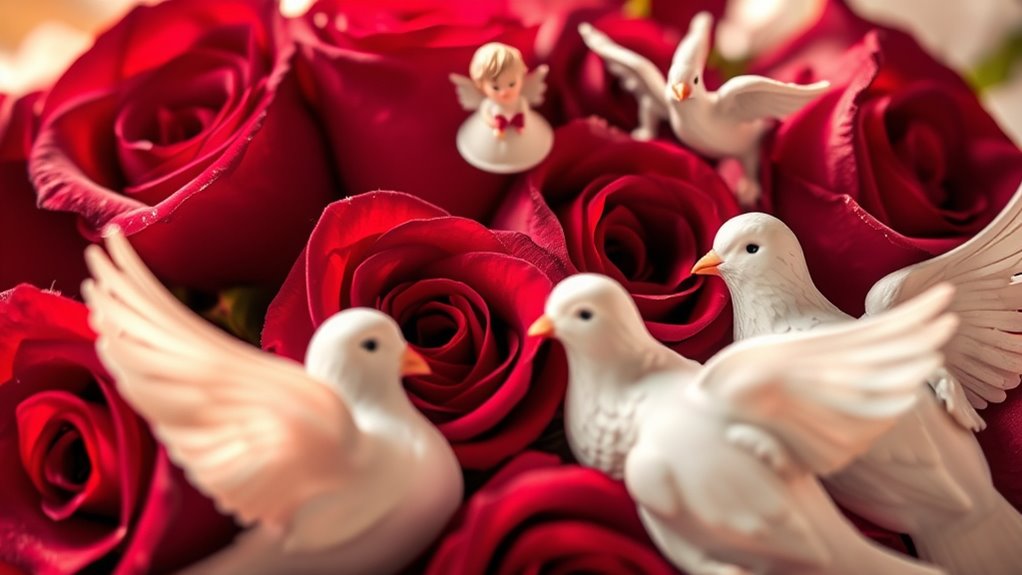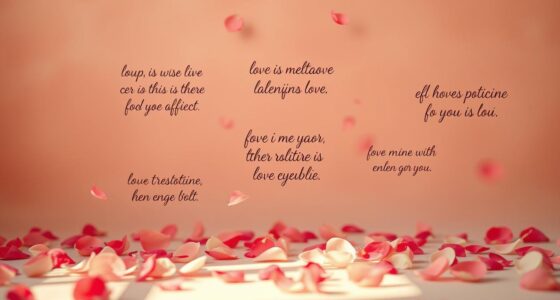Roses, doves, and Cupid are powerful symbols that embody the essence of Valentine’s Day. Roses, especially red ones, represent deep love and passion, while doves symbolize peace, loyalty, and harmony in relationships. Cupid, the playful cherub with a bow and arrow, signifies love’s spontaneity and magic. Together, these symbols highlight love’s passionate, tender, and whimsical sides. If you want to discover more about their rich meanings and origins, keep exploring their stories.
Key Takeaways
- Roses, especially red, symbolize deep love, passion, and beauty, originating from Greek and Roman mythology.
- Doves represent peace, loyalty, and harmony, emphasizing enduring and faithful romantic relationships.
- Cupid, a winged cherub, signifies playful, spontaneous love and the unpredictability of romance.
- These symbols visually express complex emotions like desire, fidelity, and affection beyond words.
- Understanding their origins enhances the meaningfulness of Valentine’s Day gestures and messages.

Valentine’s Day is celebrated with a variety of symbols that express love and affection. These symbols, like roses, doves, and Cupid, have deep roots in history and tradition, helping us convey feelings that words sometimes can’t. Understanding their origins adds meaning to the gestures we make on this special day.
Valentine’s symbols like roses, doves, and Cupid carry deep historical and emotional significance.
The history of Valentine’s Day is rich and complex. It dates back to ancient Rome, where it was originally associated with Lupercalia, a fertility festival. By the 3rd century AD, the day was linked to Saint Valentine, a Christian martyr known for secretly marrying couples in defiance of Roman laws. Over centuries, the celebration evolved from a religious commemoration to a broader expression of romantic love. Today, modern Valentine’s Day celebrations focus on exchanging cards, flowers, and gifts, emphasizing personal affection and emotional connection. Whether through grand gestures or simple acts of kindness, the day encourages us to honor love in all its forms.
Among the symbols that have become iconic on Valentine’s Day, roses stand out. Their association with love dates back to Greek and Roman mythology, where they symbolized beauty and passion. Red roses, in particular, represent deep love and desire. Giving someone a rose isn’t just about the flower itself; it’s about expressing your feelings in a way that’s timeless and universally understood. Doves, on the other hand, symbolize peace, loyalty, and harmony. Their gentle nature and pairing in mythology evoke the idea of a loving, committed relationship. When you see doves in Valentine’s imagery, it’s a reminder of the pure, enduring nature of true love.
Cupid, the mischievous winged cherub from Roman mythology, is perhaps the most recognizable symbol of Valentine’s Day. He’s often depicted with a bow and arrow, which he uses to make people fall in love. His image captures the playful, unpredictable side of romance. Cupid’s presence on Valentine’s Day cards and decorations symbolizes the idea that love can strike unexpectedly, often in a whimsical way. These symbols come together to remind us that love is both passionate and tender, spontaneous yet meaningful.
In addition, the importance of biodiversity in maintaining healthy ecosystems can be seen as a metaphor for the diversity of love and relationships celebrated on Valentine’s Day. Just as different species contribute to a resilient and vibrant environment, diverse expressions of love enrich our lives and strengthen our social fabric. These symbols serve as visual expressions of love’s many facets. Understanding their origins — from ancient rituals to modern celebrations — deepens their significance. Whether it’s giving a rose, releasing a dove, or thinking of Cupid’s playful arrow, these symbols help us communicate feelings that transcend words, making the day truly special.
Frequently Asked Questions
How Did Roses Become the Most Popular Valentine’s Day Flower?
You might wonder how roses became the top choice for Valentine’s Day. Their deep flower symbolism of love and passion makes them perfect for romantic gestures. Historically, roses have been associated with love and beauty, which helped them become a symbol of affection. Today, giving roses shows your heartfelt emotions, making them the ideal flower to express your love on this special day.
Why Are Doves Associated With Love and Peace?
Doves symbolize love and peace because their gentle nature and unwavering bonds seem almost supernatural. Their symbolism, rooted in ancient myths and religious stories, links them to divine harmony, romance, and tranquility. As symbols of dove symbolism, they represent a pure, serene connection that transcends chaos, making them perfect icons for expressing heartfelt love and peace on Valentine’s Day. Their calm presence embodies the very essence of romantic serenity and harmony.
What Is the History Behind Cupid’s Bow and Arrow?
You might wonder about Cupid’s bow and arrow, which stem from mythical origins linked to Roman gods. The bow and arrow symbolize love’s power, as they’re said to cause sudden, intense feelings of affection when struck. Their significance lies in representing love’s unpredictable and irresistible nature, reminding you that love can strike unexpectedly, just like Cupid’s arrows, making this symbol timeless in its representation of romantic longing and passion.
Are There Other Cultural Symbols Linked to Love Worldwide?
Yes, there are many cultural love symbols worldwide. You might recognize the Japanese Koi fish, symbolizing love and perseverance, or the Indian mango, representing fertility and sensuality. In Africa, the adinkra symbol “Funtunfunefu Denkyemfunefu” signifies unity in love. These global romantic icons reflect diverse traditions, helping you understand different cultural views on love. Exploring them deepens your appreciation for how love’s symbolism varies across cultures.
How Have Valentine’s Day Symbols Evolved Over Centuries?
Over centuries, Valentine’s Day symbols have evolved from historical gift customs like handwritten notes and small tokens to modern traditions like exchanging flowers, chocolates, and cards. You now celebrate with personalized gestures, reflecting cultural shifts and commercialization. This evolution shows how the emphasis on expressing love has shifted from formal, societal customs to more intimate, individual acts, making your celebrations more personal and meaningful today.
Conclusion
Now that you know the meaning behind roses, doves, and Cupid, doesn’t it make your Valentine’s Day celebration even more special? These symbols remind you of love’s beauty, peace, and passion. So, next time you see a heart-shaped box or a bouquet of red roses, will you appreciate their deeper meaning? Embrace the symbols and let them inspire you to express your love more meaningfully today and every day.









